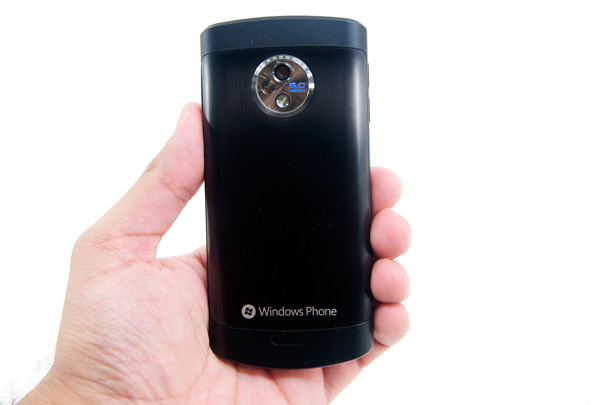LG's Optimus 7 & Samsung's Focus Reviewed: A Tale of Two Windows Phones
by Anand Lal Shimpi on December 3, 2010 10:14 PM EST- Posted in
- Smartphones
- Samsung
- Windows Phone 7
- LG Optimus
- LG
- Samsung Focus
- Mobile
Camera
Comparing smartphone cameras isn’t as easy as you’d think. You can take a bunch of shots in similar settings with different phones, but as with most things in this industry the manufacturers are all engaged in a high stakes game of tradeoffs. The obvious tradeoff up front is sensor quality vs. cost, once you make that tradeoff however there’s a lot more to worry about.
Much of how these cameras behave is up to software. There are certain things the iPhone’s camera does extremely well, and other things it just can’t ever seem to get right (e.g. white balance in certain types of CFL light). There’s also the debate of capturing reality vs. capturing what looks good. Oversaturating colors and employing TV-maker-style tricks come to mind here.
The Windows Phone 7 cameras we’ve played with have all been able to produce decent photos for web use. Given enough light and a very steady hand, you can even produce some sharp enough shots for small format prints.
I mention needing a steady hand because you are forced to use the physical shutter release button on the phone itself. The act of pushing down the button is often enough to blur a relatively slow rolling shutter.
Despite Microsoft mandating that all Windows Phone 7 devices have at least a 5MP camera, and supplying the default camera app, settings do vary between devices. For example, the HTC Surround allows you to set capture resolution but not compression level. The Focus and Optimus 7 let you do both.
The Optimus 7 adds a bunch of scene settings driven by LG’s own customizations, while the Focus has an option to enable “wide dynamic range”. The full breakdown of what you can do on these three phones is in the table below:
| Windows Phone 7 Camera App Settings Comparison | ||||
| HTC Surround | LG Optimus 7 | Samsung Focus | ||
| Scenes | Intelligent Shot | AF Mode | ||
| Effects | Beauty Shot | White Balance | ||
| Resolution | Panorama shot | Image Effect | ||
| Metering Mode | ScanSearch | Contrast | ||
| Flicker Adjustment | Photo Resolution | Saturation | ||
| Brightness | Sharpness | |||
| White Balance | EV | |||
| Color effect | ISO | |||
| Quality | Metering | |||
| Anti-shake | Photo Quality | |||
| Wide Dynamic Range | ||||
| Photo Resolution | ||||
| Anti-Shaking | ||||
It’s perplexing. Given how strict Microsoft has been elsewhere in the OS, even mandating what Start screen tiles OEMs/carriers are allowed to customize, this seems like a tremendous oversight. At the bare minimum all WP7 devices should have the same basic options to control things like JPEG quality and white balance.
The Focus has more normal camera settings while the Optimus 7’s settings are more geared towards scene control. The settings do tangibly change the image you get out of the camera in both cases.
Resolution options are also somewhat different between cameras. Although all three cameras have 5MP sensors the resolutions exposed vary among vendors:
| Windows Phone 7 Camera Resolution Settings Comparison | ||||
| HTC Surround | LG Optimus 7 | Samsung Focus | ||
| VGA (640 x 480) | 1M (1280 x 960) | VGA (640 x 480) | ||
| 1M (1280 x 960) | 3M (2048 x 1536) | 2M (1600 x 1200) | ||
| 2M (1600 x 1200) | 5M (2592 x 1944) | 3M (2048 x 1536) | ||
| 3M (2048 x 1536) | 16:9 1M (1280 x 720) | 5M (2560 x 1920) | ||
| 5M (2592 x 1944) | 16:9 2M (1920 x 1080) | |||
| 16:9 3.6M (2560 x 1440) | ||||
All three phones above feature a 4:3 5MP sensor. Only the Optimus 7 lets you shoot in a cropped 16:9 mode however. Samsung also crops its 5MP mode to 4,915,200 pixels, while the other two phones give you 5,038,848 pixels in their highest resolution mode. It’s not a big deal by any means, but curious nonetheless.
So how do these phones function as cameras? Both feature an LED flash, although the Optimus 7’s lens/flash cluster looks a bit fancier. As I mentioned before, I’d say both phones are easily capable of web quality photos; using the high resolution for detail in smaller photos vs. enabling huge images.
I’d argue that the Focus generally produces better looking images, at least more colorful, better exposed and marginally sharper ones.





























34 Comments
View All Comments
omega12 - Friday, December 3, 2010 - link
"Apple is the first company I've seen to take the pace of innovation offered by Moore's Law and pair it with an equally aggressive expected upgrade cycle."Last time i checked their hardware was not exactly up to date so I don't think you can say they are the kind that follows Moore's Law closely. Aggressive upgrade cycle they do have though.
Maybe you meant that with each upgrade they usually change their core hardware? But then again that's hardly the case. I don't get it.
sprockkets - Friday, December 3, 2010 - link
I think Moore and his law need to die. This isn't even cpus we are talking about, and Anand even referenced the stupid law when referring to SSDs.For that matter, if they really were following Moore's law they would upgrade like every 18 months, not 12, and others upgrade like every 6 months. And those ARM cpus are not getting upgrades solely based on litho process improvements either.
foolsgambit11 - Monday, December 6, 2010 - link
Moore's Law is often used a simple shorthand for referring to the rapid pace of technological innovation, and that's how it was used here. But given that, Moore's Law originally only said that the number of transistors that can be fit on a given size of silicon will double roughly every 18-24 months (Moore used different numbers at different times). So it applies equally well to SSDs.Anand Lal Shimpi - Friday, December 3, 2010 - link
I meant from an end user standpoint. The typical PC upgrade cycle is 3 - 5 years, Apple's sales strategy seems to be to shorten that cycle fairly aggressively.The holy grail a decade ago was selling PCs like cars - a new one every model year. Apple has effectively done that. It's great for Apple's bottom line for sure.
Take care,
Anand
StormyParis - Saturday, December 4, 2010 - link
Indeed, the car model-year explanation makes a lot more sense. People like getting stuff that is "new", it's an easy-to-grok upgrade cycle, and, thanks to technological progress, PC model-years mean more than cosmetics changes, which are what most car model-years are about.I'm wondering why most brands don't go with the yearly line-up refresh, probably towards the end of summer. I'm guessing PC companies still mainly see themselves as tech-driven, or even component-driven, which kinda explains why Apple is making a killing.
Pirks - Sunday, December 5, 2010 - link
"why most brands don't go with the yearly line-up refresh, probably towards the end of summer"That's because most brands are run by the Mototrolls and frobitches of the world.
wyvernknight - Monday, December 6, 2010 - link
Wow, its pirks, the persistent apple-lover from dailytech. Long time since i read one of your comments!Exelius - Monday, December 6, 2010 - link
Apple's hardware was pretty up to date when it was released; which was quite a while ago. The trick for Apple is that they underclock everything to achieve excellent battery life.Mobile hardware goes out of date pretty quickly; but I still wouldn't say the iPhone 4 is exactly ancient. They release one hardware upgrade and several software upgrades per year.
If you mean stuff other than the iPhone, then sure. But I'm not really sure they need to be the latest-and-greatest; the MBP is still easily the best selling laptop in the world and when you compare the MBP to truly comparable laptops, it's not poorly priced. Try to find a laptop with high-res, quality 15" screen, discrete switchable GPU, i5 or i7 and 5+ hours battery life... The entire package is what's important.
It's almost to Apple's advantage to sell slightly out-of-date components, so you buy a new one every year... Compare this with a company like Dell, HP or Acer where they release a new product every week, so the end-users know that whenever they want to upgrade, there will be a new product there for them to buy. With Apple, you try to time your purchase right after a major announcement.
mfenn - Friday, December 3, 2010 - link
The Youtube video on page 9 is marked as private. :(tipoo - Saturday, December 4, 2010 - link
Works fine for me, but not in the embedded player. You have to double click it to open it in youtube.